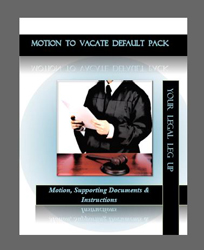Motion to Vacate or Set Aside
If you missed the time for filing your Answer or showing up in court – even by just a few minutes, there is probably a default order or judgment against you. You will need to get that order vacated or “set aside” before you can start fighting the actual case. You ask the court to do that by filing a Motion to Vacate. There are two parts to every motion to vacate – the part that explains and seeks to excuse your failure to answer, and the part that shows the court that you have some sort of defense to the suit.
These parts are separate, but both necessary, to a motion to vacate.
There are two conflicting policies behind vacating default judgments: the policy in favor of hearing every case “on the merits” (rather than letting the case be decided by a “technicality”) and the policy in favor of “finality,” which is just a way of saying that when a court has decided something it likes for things to end. When you’re a “little guy,” the courts are more interested in finality than they are for bigger economic players.
At the same time, the debt collector will fight hard to keep its default judgment – that gives it a chance to raid your bank accounts or wages at practically zero cost rather than allowing you to defend. Thus while you have a very good chance to get the default judgment removed, the motion is a little tricky, and time is of the essence, meaning that any delay in filing the motion could cause you to lose it.
Excuse for Failure to Answer
The courts don’t want you playing games with them, and they think that people should respond to lawsuits. On the other hand, winning by default is a “technicality” rather than a judgment based on the actual merits of the case, so courts do lean in favor of granting “vacatur,” or setting aside the judgment.
So what kind of an excuse will do? Well, this is trickier than you might expect, but one thing is clear: the sooner you bring your motion, the better chance you will have with it. Bringing it quickly suggests that you are taking the process seriously, and at the same time keeps things close to the time of judgment (offending the policy of “finality” of judgments, the idea that when a thing is over, it should be completely over) less.
So speed is important.
The other thing you will need to show is “good faith.” This varies from jurisdiction to jurisdiction and also can depend on how soon you bring your motion. At one end of the spectrum might be a motion to vacate brought in Missouri within a month of the judgment. In that situation, almost anything that doesn’t sound disrespectful of the court might do. That’s because a judgment isn’t “final” in Missouri until after 30 days. Car trouble, miscallendering, and other types of accident would probably work.
After thirty days in Missouri, it’s a different story. In that situation it simply requires more. Or rather, it requires that there have been less, or no, negligence. It is a tougher requirement, although just how tough the requirement you are facing will need research to determine.
Evidence May be Required
The court may (depending on jurisdiction) require proof of the facts you say constitute your good faith or other excuse. You would normally do this by affidavit, but in some situations and jurisdictions, the courts require live testimony and will ask you questions under oath.
Motion to Vacate Pack
We have a package of materials designed to help people move to vacate or set aside judgments against them. To know whether this product will work for you, you first need to know how long you have to bring the motion and when the clock starts ticking. This can vary by jurisdiction, so you must find out for your own state. In Missouri, the clock starts ticking when the judgment becomes final, and you have a year at the most to bring your motion. (And, further, it must be within a “reasonable” time after the judgment, so the sooner the better very definitely.) In New York, you also have a year, but the clock may only start ticking when you receive notice of the judgment.
You must know exactly what rule applies to you, and exactly how much time you have.
And this product will NOT apply to a motion to vacate brought because you were never served or for some other reason the court rendering judgment did not have jurisdiction over your person. Those motions would depend on state rules and would involve some degree of proof of lack of jurisdiction, but no defense would be needed, as you are arguing the court completely lacked the power to render any judgment at all. Our motion to vacate pack would not necessarily help you with that, although membership with us probably would.
The Motion to Vacate or Set Aside Default Judgment Packet consists of 9 Documents:
-
Two Sample Motions
-
An “annotated” Motion – to be used as a model for cutting and pasting
-
A Sample Affidavit
-
Sample Memorandum in Support
- Sample Proposed Answer and Counterclaim
- Instructions
- Case law notes
- Report on Default Judgments and Motions to Vacate.
Although this is not “cut and paste” you will find this document, along with the directions, just what you need to file your Motion to Vacate and to get started defending yourself so you can keep the debt collectors from garnishing your wages or raiding your bank account.




